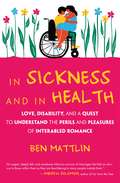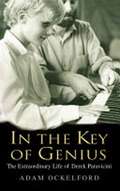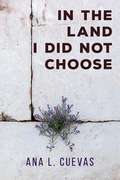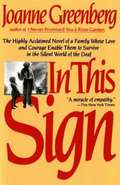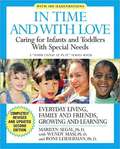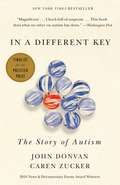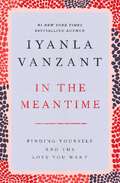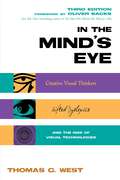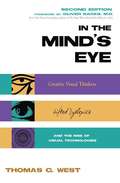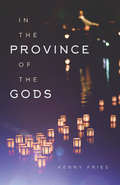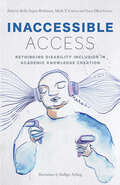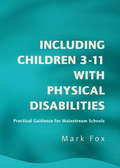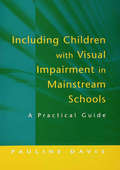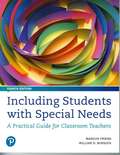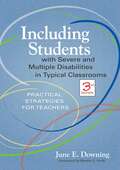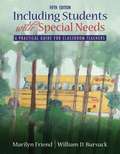- Table View
- List View
In Sickness and in Health: Love, Disability, and a Quest to Understand the Perils and Pleasures ofInterabled Romance
by Ben MattlinA frank, humorous exploration of interabled dating, love, and marriageBen Mattlin’s wife, ML, recalls falling in love with his confidence and sheer determination. On one of their earliest dates, he persuaded her to ride on his lap in his wheelchair on their way home from an Elvis Costello concert. Thirty years later, they still travel like this from time to time, undaunted by the curious stares following them down the street.But In Sickness and in Health is more than an “inspiring” story of how a man born with spinal muscular atrophy—a congenital and incurable neuromuscular condition—survived childhood, graduated from Harvard, married an able-bodied woman, built a family with two daughters and a cat and a turtle, established a successful career in journalism, and lived happily ever after. As Mattlin considers the many times his relationship has been met with surprise or speculation by outsiders—those who consider his wife a “saint” or him just plain “lucky” for finding love—he issues a challenge to readers: why should the idea of an “interabled” couple be regarded as either tragic or noble?Through conversations with more than a dozen other couples of varying abilities, ethnic backgrounds, and orientations, Mattlin sets out to understand whether these pairings are as unusual as onlookers seem to think. Reflecting on his own experience he wonders: How do people balance the stresses of personal-care help with the thrill of romance? Is it possible that the very things that appear to be insurmountable obstacles to a successful relationship—the financial burdens, the physical differences, the added element of an especially uncertain future—could be the building blocks of an enviable level of intimacy and communication that other couples could only dream of?We meet Shane Burcaw, a twenty-three-year-old writer, who offers a glimpse of his first forays into dating with a disability. There’s Rachelle Friedman, the “paralyzed bride,” as the media refers to her, and her husband, discussing the joys and challenges of a new marriage and a growing family. And Christina Crosby and her partner, Janet Jakobsen, reflect on how Crosby’s disabling accident called for them to renegotiate their roles and expectations in their long-term relationship. What emerges is a candid glimpse into the challenges and joys of interabled love—from the first blush of sexual awakening to commitment and marriage and through to widowhood.
In The Key Of Genius: The Extraordinary Life Of Derek Paravicini
by Adam OckelfordDerek Paravicini is blind, can't tell his right hand from his left and needs round-the-clock care. But he has an extremely rare gift - he is a musical prodigy with perfect pitch whose piano-playing has thrilled audiences at venues from Ronnie Scott's to Las Vegas, the Barbican to Buckingham Palace. <p><p> Born prematurely, Derek remained in hospital for three months and technically 'died' several times before he was finally strong enough to go home. It was not long before his blindness became apparent and later it became clear that he had severe learning difficulties and autism. <p> Desperately trying to find something to engage and stimulate baby Derek, his nanny discovered a toy organ and put it down in front of him. Miraculously, Derek taught himself to play. Music proved to be an outlet for expressing himself and communicating with others - his way of dealing with a strange and confusing world.
In The Land I Did Not Choose
by Ana L. CuevasPrejudice and discrimination against people with mental and physical disabilities still exist. Ana L. Cuevas, a blind woman, knows this all too well. But she also knows compassion, love, and courage. This book is a testament to her determination to reach her dreams no matter the obstacles. As a young girl, Ana moved to the United States from Mexico against her will. Her parents picked this country, and though it has its faults, Ana is forever grateful. This land is where she received the proper education and tools to lead a full life. However, while researching pregnancy and disabilities, Ana realizes she is considered different in the eyes of others. Many "able-bodied" people assume blindness affects intelligence, speech, and other capabilities. Knowing this changes the way Ana looks at the world. This is a problem that must be addressed by the public and the government to alleviate prejudices and help people with disabilities achieve the same success as their peers. This poignant memoir will have you cheering, crying, and standing up for love and acceptance of all people in this world. It is a must-read for counselors, social workers, psychologists, and teachers.
In This Sign
by Joanne GreenbergJanice and Abel are a deaf couple. Their daughter can hear, and becomes their interpreter from a very early age. The parents are ashamed of their sign language and won't sign in public, only at the deaf club or with deaf friends. The daughter is interpreting phone calls, medical and banking appointments, legal and other situations long before she understands them. This is a historical novel, of a deaf world that no longer exists, but is accurate for its time.
In Time and with Love
by Marilyn SegalWritten in a jargon-free, parent-friendly style, this generously illustrated book is filled with advice on such topics as nursing, feeding, dressing, interacting with siblings, discipline, and social skills development of handicapped children. Includes a section on games and activities that encourage motor and language skills, and advice on play and care for toddlers and older children.
In a Different Key
by Caren Zucker John DonvanNearly seventy-five years ago, Donald Triplett of Forest, Mississippi became the first child diagnosed with autism. Beginning with his family's odyssey, In a Different Key tells the extraordinary story of this often misunderstood condition, and of the civil rights battles waged by the families of those who have it. Unfolding over decades, it is a beautifully rendered history of ordinary people determined to secure a place in the world for those with autism--by liberating children from dank institutions, campaigning for their right to go to school, challenging expert opinion on what it means to have autism, and persuading society to accept those who are different. It is the story of women like Ruth Sullivan, who rebelled against a medical establishment that blamed cold and rejecting "refrigerator mothers" for causing autism; and of fathers who pushed scientists to dig harder for treatments. Many others played starring roles too: doctors like Leo Kanner, who pioneered our understanding of autism; lawyers like Tom Gilhool, who took the families' battle for education to the courtroom; scientists who sparred over how to treat autism; and those with autism, like Temple Grandin, Alex Plank, and Ari Ne'eman, who explained their inner worlds and championed the philosophy of neurodiversity. This is also a story of fierce controversies--from the question of whether there is truly an autism "epidemic," and whether vaccines played a part in it; to scandals involving "facilitated communication," one of many treatments that have proved to be blind alleys; to stark disagreements about whether scientists should pursue a cure for autism. There are dark turns too: we learn about experimenters feeding LSD to children with autism, or shocking them with electricity to change their behavior; and the authors reveal compelling evidence that Hans Asperger, discoverer of the syndrome named after him, participated in the Nazi program that consigned disabled children to death.By turns intimate and panoramic, In a Different Key takes us on a journey from an era when families were shamed and children were condemned to institutions to one in which a cadre of people with autism push not simply for inclusion, but for a new understanding of autism: as difference rather than disability.
In a Different Key: The Story of Autism
by Caren Zucker John DonvanAn extraordinary narrative history of autism: the riveting story of parents fighting for their children 's civil rights; of doctors struggling to define autism; of ingenuity, self-advocacy, and profound social changeNearly seventy-five years ago, Donald Triplett of Forest, Mississippi, became the first child diagnosed with autism. Beginning with his family's odyssey, In a Different Key tells the extraordinary story of this often misunderstood condition, and of the civil rights battles waged by the families of those who have it. Unfolding over decades, it is a beautifully rendered history of ordinary people determined to secure a place in the world for those with autism--by liberating children from dank institutions, campaigning for their right to go to school, challenging expert opinion on what it means to have autism, and persuading society to accept those who are different. It is the story of women like Ruth Sullivan, who rebelled against a medical establishment that blamed cold and rejecting "refrigerator mothers" for causing autism; and of fathers who pushed scientists to dig harder for treatments. Many others played starring roles too: doctors like Leo Kanner, who pioneered our understanding of autism; lawyers like Tom Gilhool, who took the families' battle for education to the courtroom; scientists who sparred over how to treat autism; and those with autism, like Temple Grandin, Alex Plank, and Ari Ne'eman, who explained their inner worlds and championed the philosophy of neurodiversity. This is also a story of fierce controversies--from the question of whether there is truly an autism "epidemic," and whether vaccines played a part in it; to scandals involving "facilitated communication," one of many treatments that have proved to be blind alleys; to stark disagreements about whether scientists should pursue a cure for autism. There are dark turns too: we learn about experimenters feeding LSD to children with autism, or shocking them with electricity to change their behavior; and the authors reveal compelling evidence that Hans Asperger, discoverer of the syndrome named after him, participated in the Nazi program that consigned disabled children to death.By turns intimate and panoramic, In a Different Key takes us on a journey from an era when families were shamed and children were condemned to institutions to one in which a cadre of people with autism push not simply for inclusion, but for a new understanding of autism: as difference rather than disability.From the Hardcover edition.
In a Different Key: The Story of Autism
by Caren Zucker John DonvanAn extraordinary narrative history of autism: the riveting story of parents fighting for their children ’s civil rights; of doctors struggling to define autism; of ingenuity, self-advocacy, and profound social changeNearly seventy-five years ago, Donald Triplett of Forest, Mississippi, became the first child diagnosed with autism. Beginning with his family’s odyssey, In a Different Key tells the extraordinary story of this often misunderstood condition, and of the civil rights battles waged by the families of those who have it. Unfolding over decades, it is a beautifully rendered history of ordinary people determined to secure a place in the world for those with autism—by liberating children from dank institutions, campaigning for their right to go to school, challenging expert opinion on what it means to have autism, and persuading society to accept those who are different. It is the story of women like Ruth Sullivan, who rebelled against a medical establishment that blamed cold and rejecting “refrigerator mothers” for causing autism; and of fathers who pushed scientists to dig harder for treatments. Many others played starring roles too: doctors like Leo Kanner, who pioneered our understanding of autism; lawyers like Tom Gilhool, who took the families’ battle for education to the courtroom; scientists who sparred over how to treat autism; and those with autism, like Temple Grandin, Alex Plank, and Ari Ne’eman, who explained their inner worlds and championed the philosophy of neurodiversity. This is also a story of fierce controversies—from the question of whether there is truly an autism “epidemic,” and whether vaccines played a part in it; to scandals involving “facilitated communication,” one of many treatments that have proved to be blind alleys; to stark disagreements about whether scientists should pursue a cure for autism. There are dark turns too: we learn about experimenters feeding LSD to children with autism, or shocking them with electricity to change their behavior; and the authors reveal compelling evidence that Hans Asperger, discoverer of the syndrome named after him, participated in the Nazi program that consigned disabled children to death.By turns intimate and panoramic, In a Different Key takes us on a journey from an era when families were shamed and children were condemned to institutions to one in which a cadre of people with autism push not simply for inclusion, but for a new understanding of autism: as difference rather than disability.— Washington Post, Notable Non-fiction Books in 2016— WBUR, Best Books of 2016— Wall Street Journal, Best Books of the Year
In a Different Key: The Story of Autism
by Caren Zucker John DonvanAn extraordinary narrative history of autism: the riveting story of parents fighting for their children ’s civil rights; of doctors struggling to define autism; of ingenuity, self-advocacy, and profound social changeNearly seventy-five years ago, Donald Triplett of Forest, Mississippi, became the first child diagnosed with autism. Beginning with his family’s odyssey, In a Different Key tells the extraordinary story of this often misunderstood condition, and of the civil rights battles waged by the families of those who have it. Unfolding over decades, it is a beautifully rendered history of ordinary people determined to secure a place in the world for those with autism—by liberating children from dank institutions, campaigning for their right to go to school, challenging expert opinion on what it means to have autism, and persuading society to accept those who are different. It is the story of women like Ruth Sullivan, who rebelled against a medical establishment that blamed cold and rejecting “refrigerator mothers” for causing autism; and of fathers who pushed scientists to dig harder for treatments. Many others played starring roles too: doctors like Leo Kanner, who pioneered our understanding of autism; lawyers like Tom Gilhool, who took the families’ battle for education to the courtroom; scientists who sparred over how to treat autism; and those with autism, like Temple Grandin, Alex Plank, and Ari Ne’eman, who explained their inner worlds and championed the philosophy of neurodiversity. This is also a story of fierce controversies—from the question of whether there is truly an autism “epidemic,” and whether vaccines played a part in it; to scandals involving “facilitated communication,” one of many treatments that have proved to be blind alleys; to stark disagreements about whether scientists should pursue a cure for autism. There are dark turns too: we learn about experimenters feeding LSD to children with autism, or shocking them with electricity to change their behavior; and the authors reveal compelling evidence that Hans Asperger, discoverer of the syndrome named after him, participated in the Nazi program that consigned disabled children to death.By turns intimate and panoramic, In a Different Key takes us on a journey from an era when families were shamed and children were condemned to institutions to one in which a cadre of people with autism push not simply for inclusion, but for a new understanding of autism: as difference rather than disability.
In a Different Key: The Story of Autism
by Caren Zucker John DonvanAn extraordinary narrative history of autism: the riveting story of parents fighting for their children ’s civil rights; of doctors struggling to define autism; of ingenuity, self-advocacy, and profound social changeNearly seventy-five years ago, Donald Triplett of Forest, Mississippi, became the first child diagnosed with autism. Beginning with his family’s odyssey, In a Different Key tells the extraordinary story of this often misunderstood condition, and of the civil rights battles waged by the families of those who have it. Unfolding over decades, it is a beautifully rendered history of ordinary people determined to secure a place in the world for those with autism—by liberating children from dank institutions, campaigning for their right to go to school, challenging expert opinion on what it means to have autism, and persuading society to accept those who are different. It is the story of women like Ruth Sullivan, who rebelled against a medical establishment that blamed cold and rejecting “refrigerator mothers” for causing autism; and of fathers who pushed scientists to dig harder for treatments. Many others played starring roles too: doctors like Leo Kanner, who pioneered our understanding of autism; lawyers like Tom Gilhool, who took the families’ battle for education to the courtroom; scientists who sparred over how to treat autism; and those with autism, like Temple Grandin, Alex Plank, and Ari Ne’eman, who explained their inner worlds and championed the philosophy of neurodiversity. This is also a story of fierce controversies—from the question of whether there is truly an autism “epidemic,” and whether vaccines played a part in it; to scandals involving “facilitated communication,” one of many treatments that have proved to be blind alleys; to stark disagreements about whether scientists should pursue a cure for autism. There are dark turns too: we learn about experimenters feeding LSD to children with autism, or shocking them with electricity to change their behavior; and the authors reveal compelling evidence that Hans Asperger, discoverer of the syndrome named after him, participated in the Nazi program that consigned disabled children to death.By turns intimate and panoramic, In a Different Key takes us on a journey from an era when families were shamed and children were condemned to institutions to one in which a cadre of people with autism push not simply for inclusion, but for a new understanding of autism: as difference rather than disability.
In the High Valley (Katy #5)
by Susan CoolidgeThe final book in the Katy series focuses on Clover and Elsie as they make their homes in the High valley in the beauty of the Rocky Mountains. Follow their simple life that brings joy to all who visit! This anthology is a thorough introduction to classic literature for those who have not yet experienced these literary masterworks. For those who have known and loved these works in the past, this is an invitation to reunite with old friends in a fresh new format. From Shakespeare's finesse to Oscar Wilde's wit, this unique collection brings together works as diverse and influential as The Pilgrim's Progress and Othello. As an anthology that invites readers to immerse themselves in the masterpieces of the literary giants, it is must-have addition to any library.
In the Meadow of Fantasies
by Hadi MohammadiWritten by the winner of IBBY's Best Book Award, Mohammad Hadi Mohammadi, In the Meadow of Fantasies is one girl's luminous escapade into a land of seven mysterious horses.A young girl with a physical disability gazes up at a mobile of spinning horses from her little pink bed in her room filled with leafy plants. As she watches them prance about, the tufted snout of a real live horse peeks through her bedroom door. Soon enough, our bright protagonist is off and cantering on an adventure with seven majestic horses. The first six are easily understood: their colors, dreams, families, and origins are described and accompanied with exquisite drawings. The seventh horse, however, is an enigmatic creature with no clear hue or history, a lack that is soon filled in by the loving offerings of the other ponies. A story about dreaming and about caring for others, In the Meadow of Fantasies will remind young readers of their own reveries and conjure new fantasies of friendly creatures in far off lands.
In the Meantime: Finding Yourself and the Love You Want (Inspirational Ser.)
by Iyanla Vanzant&“The most powerful spiritual healer, fixer, teacher on the planet.&” —Oprah Winfrey The #1 national bestseller from the host of the show Iyanla: Fix My Life on the Oprah Winfrey Network (OWN) that answers the question: What&’s love got to do with it in the meantime?You know where you want to be, but you have no clue how to get there. You know exactly what you want in life, but what you want is nowhere in sight. Perhaps your vision is unclear, your purpose still undefined. On top of it all, your relationships, particularly your romantic relationships, are failing. If these scenarios feel familiar way down in the deepest part of your gut—then you, my dear, are smack dab in the middle of the meantime. Every living being wants to experience the light of love. The problem is that our windows are dirty! The windows of our hearts and minds are streaked with past pains and hurts, past memories and disappointments. In this book, Iyanla Vanzant teaches us how to do our mental housekeeping so that we can clean the windows, floors, walls, closets, and corners of our minds. If we do a good job, our spirits will shine bringing in the light of true love and happiness.
In the Mind's Eye: Creative Visual Thinkers, Gifted Dyslexics, and the Rise of Visual Technologies
by Thomas G. WestIn the Mind's Eye has been recognized as a classic in its field. The book still stands alone as a uniquely compelling argument for the great importance of visual thinking and visual technologies as well as the high creative potential of many individuals with dyslexia or other learning difficulties. In this third edition, Thomas G. West reviews a number of recent developments that support and extend the perspectives and expectations originally set forth in the first edition. In addition to the original eleven portraits of famous individuals with learning difficulties (including Albert Einstein and Thomas Edison), he has added brief profiles of two dyslexic scientists known for their ability to generate, in quite different fields, powerful but unexpected innovations and discoveries: William J. Dreyer, a Caltech professor who used his highly visual imagination to see things in molecular biology and immunology well before others; and John R. (Jack) Horner, who flunked out of the University of Montana seven times (requiring letters of support for readmission) but is now known as one of the three most important paleontologists in the world. Recognized as among the "best of the best" by the American Library Association in their broad psychology and neuroscience category, this title belongs on the bookshelves of all educators and anyone with an interest in visual thinking, visual technologies, and highly creative people with learning difficulties.
In the Mind's Eye: Visual Thinkers, Gifted People with Dyslexia and Other Learning Disabilities, Computer Images and the Ironies of Creativity
by Thomas G. WestExposes myths about conventional intelligence by examining the role of visual-spatial strengths and verbal weaknesses in the lives of 11 gifted individuals, including Albert Einstein and Thomas Edison. Examines research in neuroscience that shows a link between visual talents and verbal difficulties, and discusses developments in computer technology that herald a shift toward the increased use of visual approaches in business and science. This revised edition offers an expanded list of national and international organizations, and an updated bibliography. Annotation c. by Book News, Inc., Portland, Or.
In the Province of the Gods
by Kenny FriesKenny Fries embarks on a journey of profound self-discovery as a disabled foreigner in Japan, a society historically hostile to difference. As he visits gardens, experiences Noh and butoh, and meets artists and scholars, he also discovers disabled gods, one-eyed samurai, blind chanting priests, and A-bomb survivors. When he is diagnosed as HIV positive, all his assumptions about Japan, the body, and mortality are shaken, and he must find a way to reenter life on new terms.
In the Shadow of the Tower (Dana Girls Mystery #3)
by Carolyn KeeneDana and Louise stumble upon another mystery as they overhear a cripple crying. When they visit Cousin Bessie at Barnwold farm the mystery deepens.
Inaccessible Access: Rethinking Disability Inclusion in Academic Knowledge Creation
by Michele Friedner Sumi Colligan Mark T. Carew Erin L. Durban Indigo Ayling Carol Rivas Julia F. Sauma Julia K. Modern Valéria Aydos Harshadha Balasubramanian Rebekah Cupitt Sara M. Acevedo Valerie Black Nell A. Koneczny Krisjon Olson Mark R. BookmanInaccessible Access ethnographically addresses barriers to inclusion within knowledge-making. It focuses on the social, environmental, communicative, and epistemological barriers that people with disabilities confront and embody throughout the course of their learning and living and in the specific context of their higher education institutions and in research. It is presented by a neurodiverse, disabled, and non-cis cohort of authors, all of whom acknowledge a continuum of (in)access that is available to each contributor contingent on their inherent intersectionalities and alterities. The authors and editors of this book foreground the work that has yet to be done on recognizing the value of nonnormative ways of approaching, being in, and knowing research and higher education, particularly in cases where disablity-centered epistemologies are sidelined in confrontation with institutional norms, even within existing discourses concerning equality and alterity.
Incidents in the Life of a Blind Girl
by Mary L. DayOrphaned at ten and blinded at twelve, Mary L. Day eventually studied at the Maryland Institute for the Blind and wrote this memoir in her early twenties. She describes her ordeals at the hands of doctors who attempted to restore her sight, her solo travels by train, and her education with other blind students. Although her book is laced with Victorian poetry and pathos, much of Mary's story still rings true today.
Including Children 3-11 With Physical Disabilities: Practical Guidance for Mainstream Schools
by Mark FoxFirst Published in 2005. Routledge is an imprint of Taylor & Francis, an informa company.
Including Children with Visual Impairment in Mainstream Schools: A Practical Guide
by Pauline DavisFirst Published in 2003. Routledge is an imprint of Taylor & Francis, an informa company.
Including People With Disabilities in Faith Communities: A Guide for Service Providers, Families, and Congregations
by Erik W. CarterA congregational community is an ideal place to share and strengthen faith, form lasting relationships, and develop special gifts and talents. Too often, though, people with developmental and other disabilities lack the opportunities and supports to fully participate in the life of their faith community. That's why families and service providers need to read this groundbreaking guidebook--and share a copy with congregations that want to become places of welcome and belonging for people with disabilities. Bringing his practical ideas to life with anecdotes, quotes, and examples of successful strategies, Erik Carter helps readers reflect on how welcoming their congregation is--and could be--for people with disabilities and their families articulate and pursue a bold vision of inclusion throughout their congregation, community, city, or state take steps to break down attitudinal, architectural, programmatic, and other barriers to inclusion design appropriate, inclusive religious education programs for children, youth, and adults learn how service providers can actively support the spiritual preferences, strengths, and needs of people with disabilities To make inclusion work in any faith community, this how-to book gives readers workable strategies and photocopiable forms for identifying indicators of welcome; encouraging community outreach, and gathering important information about the support needs of people with disabilities and their families.
Including Students With Special Needs: A Practical Guide For Classroom Teachers
by Marilyn Friend William D. BursuckIncluding Students with Special Needs provides readers with a firm grounding in critical special education concepts, an understanding of the professionals who support students with special needs, knowledge of the procedures that should be followed to ensure that students with special needs rights are upheld, and a wealth of research-based strategies and interventions that we know help foster student success. Filled with realistic school scenarios, additional vignettes of children with disabilities and other special needs, new information on multi-tiered systems of support, and over 400 new reference citations, the 8th Edition introduces pre-service teachers to the complexities, realities, and rewards of being a professional educator today.
Including Students with Severe and Multiple Disabilities in Typical Classrooms: Practical Strategies for Teachers
by June E. Downing Martha E. SnellThe bestselling resource from the most trusted name in special education gets a top-to-bottom update in this new third edition. Revised to reflect the realities of today's K-12 classrooms, this book gives teachers all the latest research-based, practical strategies for fully including students with sensory impairments and cognitive and physical disabilities.
Including Students with Special Needs
by Marilyn Friend William D. BursuckThis single most-adopted Inclusion text worldwide continues to provide the best source of practical strategies for teaching students with special needs in inclusive settings. Filled with examples and vignettes, the emphasis is always on teaching methods that promote student independence at all education levels.
